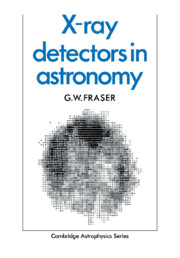Book contents
- Frontmatter
- Contents
- Preface
- Acknowledgements
- Units and constants
- 1 Observational techniques in X-ray astronomy
- 2 Proportional counters
- 3 Microchannel plates
- 4 Semiconductor detectors
- 5 Scintillators, phosphors and NEADs
- 6 Single photon calorimeters
- Appendix A Observational X-ray astronomy: a bibliography
- Appendix B X-ray data analysis techniques
- References
- Index
4 - Semiconductor detectors
Published online by Cambridge University Press: 21 May 2010
- Frontmatter
- Contents
- Preface
- Acknowledgements
- Units and constants
- 1 Observational techniques in X-ray astronomy
- 2 Proportional counters
- 3 Microchannel plates
- 4 Semiconductor detectors
- 5 Scintillators, phosphors and NEADs
- 6 Single photon calorimeters
- Appendix A Observational X-ray astronomy: a bibliography
- Appendix B X-ray data analysis techniques
- References
- Index
Summary
Introduction
This chapter describes the use in X-ray astronomy of semiconductor ionisation detectors as non-dispersive spectrometers of high energy resolution. Semiconductor detectors which operate on a calorimeteric principle are described separately, in Chapter 6.
The early history of semiconductor radiation detectors is comprehensively described by McKenzie (1979). The first practical ‘solid state’ detectors – the term is usually taken to exclude scintillation counters (Chapter 5) – were small germanium surface barrier devices with gold electrodes (section 4.2.1), fabricated in the late 1950s. Such devices could be regarded as solid state analogues of the gas-filled ionisation chamber (Wilkinson, 1950), in that the primary ionisation produced in the dielectric and collected, without multiplication, by its internal electric field, was found to be proportional to the energy of an incident particle.
Over the past 30 years, improvements in material purity (Eichinger, 1987) and advances in microelectronic process technology have given rise to an array of detector types based on electron-hole pair creation in cooled silicon or germanium or in a number of ‘room temperature’ materials, of which the most developed is currently mercuric iodide. As in the case of gas-filled detectors (Chapter 2) much of the impetus for the new semiconductor detectors comes from the particle physics community (Kemmer and Lutz, 1987). Trends in modern particle physics include the development of both large (1 m2) silicon detector arrays (Borer et al. 1987) and of integrated detectors in which some at least of the signal processing is embodied ‘on chip’.
In X-ray astronomy, however, solid state detector research is still driven primarily by the desire for high spectral resolution.
- Type
- Chapter
- Information
- X-ray Detectors in Astronomy , pp. 179 - 229Publisher: Cambridge University PressPrint publication year: 1989

